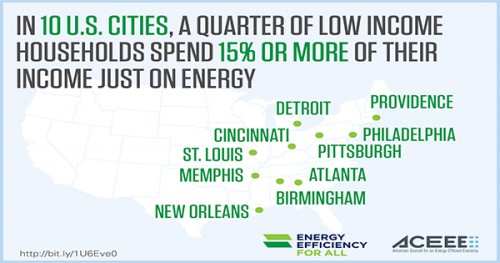— Low-Income Households in Memphis, Birmingham, Atlanta, New Orleans, Providence, Pittsburgh, Dallas, Philadelphia, Kansas City, and Cleveland Suffer Heaviest “Energy Burden” —

Washington, DC — An “energy burden” review of 48 major U.S. metropolitan areas finds that low-income households devote up to three times as much income to energy costs as do other, higher-income households. The new report from the American Council for an Energy-Efficient Economy (ACEEE) and the Energy Efficiency for All (EEFA) coalition also finds that African-American and Latino households spend disproportionate amounts of their income on energy and that more energy efficiency measures would help close the gap by at least one-third.
* On average, low-income households pay 7.2 percent of household income on utilities – more than three times the amount that higher income households pay (2.3 percent).
* Energy burdens were found to be greatest for low-income households in the following 10 major cities: Memphis (13.2 percent of income), Birmingham (10.9 percent), Atlanta (10.2 percent), New Orleans (9.8 percent), Providence (9.5 percent), Pittsburgh (9.4 percent), Dallas (8.8 percent), Philadelphia (8.8 percent), Kansas City (8.5 percent), and Cleveland (8.5 percent).
* For African-American households, the cities with the greatest energy burdens were: Memphis, Pittsburgh, New Orleans, Kansas City, Birmingham, Milwaukee, St. Louis, Cleveland, Cincinnati, and Atlanta.
* Latino households experience the greatest energy burdens in: Memphis, Providence, Philadelphia, Kansas City, Atlanta, Birmingham, Phoenix, Dallas, Fort Worth, and Detroit.
* If low-income housing stock were brought up to the efficiency level of the average US home, this would eliminate 35 percent of the average low-income energy burden of low-income households. For African-American and Latino households, 42 percent and 68 percent of the excess energy burden, respectively, would be eliminated.
* The five cities with the lowest median energy burdens for all households were San Francisco (1.4 percent), San Jose (1.8 percent), Seattle (2.1 percent), Washington, DC (2.1 percent), and San Diego (2.3 percent).
Jacqueline Patterson, director, Environmental and Climate Justice Program, NAACP, said: “For the communities we serve who are disproportionately plagued by pollution from energy production, for families who have to make choices between proper nutrition and keeping the lights on, and for unemployed persons for whom retrofitting and weatherization may provide a pathway out of poverty, this report illuminates the challenges and provides guidance on solutions that will result in healthier and more economically vibrant communities.”
Ariel Drehobl, research analyst and lead report author, ACEEE, said: “We found that the overwhelming majority of low-income and households of color in major US cities experienced higher energy burdens when compared to the average household in the same city. Families who face higher energy burdens experience many negative long-term effects on their health and well-being. These families are at greater risk for respiratory diseases and increased stress, and they can experience increased economic hardship and difficulty in moving out of poverty.”
Adrianna Quintero, executive director, Voces Verdes, said: “Increasing the energy efficiency of Latino households to the median level could cut their excess energy burdens by as much as a whopping 68 percent, putting more money in their pockets for things like food and, medical expenses.”
Khalil Shahyd, representative, Energy Efficiency for All coalition (which includes the Natural Resources Defense Council where he is a project manager of the Urban Solutions Program), said: “Increasing investments in energy efficiency can help improve energy affordability for all of America’s households, renters and owners alike, and this is especially critical for low-income renters whose energy burdens are more than three times higher. Cutting energy waste by improving energy efficiency leads to more comfortable homes; healthier, more prosperous communities; and is the quickest and most cost-effective way to reduce the dangerous carbon pollution fueling climate change. Energy efficiency is a practical solution for climate change, one that all people can participate in directly and experience direct benefits from.”
Other key findings include the following:
* The Southeast and Midwest regions had the highest average energy burdens across all groups.
* Overall, low-income households experienced the highest median energy burden (7.2 percent), followed by African-American households (5.4 percent), low-income households living in multifamily buildings (5.0 percent), Latino households (4.1 percent), and renting households (4.0 percent).
* In 17 cities — which is more than one-third of the cities studied — a quarter of low-income households experienced an energy burden greater than 14 percent, substantially higher than the 3.5 percent median for all households.
* On average, African-American and white households paid similar utility bills, but African-American households experienced a median energy burden 64 percent greater than white households (5.4 percent and 3.3 percent, respectively). Latino households paid lower utility bills, on average, than African-American and white households did, yet they experienced a median energy burden 24 percent greater than white households (4.1 percent and 3.3 percent, respectively).
* Renter households also experienced higher energy burdens (4.0 percent and 3.3 percent, respectively). Renters pay almost 20 percent more per square foot than home owners, indicating that they live in less efficient homes.
* Experiencing high energy burdens can greatly affect the mental and physical health of families by increasing financial stress, cases of asthma, respiratory problems, heart disease, arthritis, and rheumatism. Children and the elderly are most susceptible to these health impacts caused by improperly heated or cooled homes.
* Increasing investment in energy efficiency programs is an underutilized strategy that could compliment bill assistance and weatherization programs to help reduce high energy burdens in underserved communities. Suggested approaches include: targeting multifamily buildings with energy efficiency investments; using demographic data in program evaluation; and strengthening low-income targets and goals for utility programs.
* States also could prioritize increasing energy efficiency programs in their plans to comply with the EPA’s Clean Power Plan to limit power plant emissions, and could opt in to the Clean Energy Incentive Program, which offers early credit for efficiency projects in low-income communities during the two years prior to the start of the compliance period.
PRESS CONTACT:
Patrick Mitchell
(703) 276-3266
pmitchell@hastingsgroup.com
